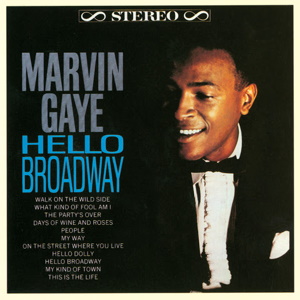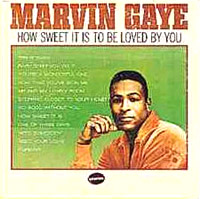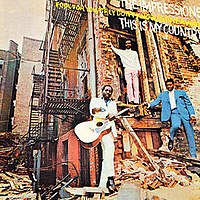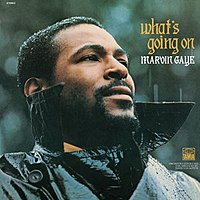Album links need updating to Spotify.... March 2019
Marvin Gaye was a Motown recording artist who either solo or in duet with several female singers released some popular singles in the Sixties, such as "
I Heard It Through the Grapevine", "
How Sweet It Is To be Loved By You", "
Ain't No Mountain High Enough", and "
Ain't Nothing Like the Real Thing". In the Seventies, influenced by Curtis Mayfield, Isaac Hayes and Norman Whitfield, he released the critically acclaimed
What's Going On album, and - amongst some poorer quality albums,
Let's Get It On, and in 1982 Midnight Love, his best selling album, which contained the track "Sexual Healing".
A somewhat shy and troubled individual who had a difficult relationship with his father; at the end of his life, plagued by huge tax debt and struggling to overcome drug dependence, he moved back in with his parents, and was shot dead by his father.
Gaye's reputation rests largely on the Let's Get It On and, in particular, the What's Going On albums. Though he derived the ideas and sounds for those albums from other artists, his commercial success made it seem as though the ideas were his, and so he is credited with introducing or promoting new soul sounds such as
disco,
funk and
smooth soul, and for bringing social and sexual awareness to black music. Acclaim for his albums appears to be somewhat overstated, though his commercial appeal cannot be denied, and he did help promote the smooth soul sound and influence other artists in that genre. A dubious honour.
Debut album released June1961
as the second LP by Motown. Mostly consisting of standards, "My Funny Valentine", "Witchcraft", etc, the album is a little plain, but it indicates that the 21 year old had a pleasant voice and a good sense of modulation. Rating: 2
Gaye's second album, released Dec 1962, is a significant step forward from the first. Six of the 10 songs were co-written by Gaye, including "
Hitch Hike", his first top 30 hit, "
Pride and Joy", his first top 10, and "
Wherever I Lay My Hat (That's My Home)", a later hit for Paul Young. Rating: 3
After a live album, Gaye returned to his love of jazz standards. It wasn't successful, and while not awful, is not an album worth seeking out. Rating: 2
 |
| Marvin Gaye & Mary Wells Together (1964) |
After a Greatest Hits release, also in 1964, Motown paired Gaye with Wells, who had already had a hit with "
My Guy"; two top 20 singles were released, "
Once Upon a Time" and "
What's the Matter With You", and the album became Gaye's first to chart. It has the feel of a standard Motown album. Listenable, but not memorable. Rating: 2
 |
| Hello Broadway (1964) |
The fourth Gaye album to be released in 1964 was another attempt at standards both smooth and jazzed up. This, apparently, is what Gaye himself wanted to do. The RnB and Soul material, such as that of A Stubborn Kinda Fellow, which he could do so well for himself and other people, was what Berry Gordy wanted him to do. But he preferred to concentrate on this schmaltz. Album includes "
People", and "
Walk On The Wild Side". It's competent enough, but never really lifts, and is far from original. Rating: 2
 |
| How Sweet It Is To Be Loved By You (1965) |
In September 1964 Gaye had a hit with the Holland Dozier Holland song, "
How Sweet It Is To be Loved By You"; in typical Motown style the single was followed by the cash in album - a bunch of competent but indifferent songs written by the Motown staffers, including one co-written by Gaye: "
Need Your Lovin' (Want You Back)". The title song is great, but the album sadly isn't. Rating: 2
Another attempt at being a singer of standards. This is a strong album of its type - Gaye is a competent singer, and handles these songs well. But there's nothing really distinctive here. If you like these songs, you'll find this a pleasant album, but you won't be excited or disturbed. Rating: 3
 |
| Moods of Marvin Gaye (1966) |
Moving back to Motown songs, this album contains some songs by Smokey Robinson, including "
I'll Be Doggone" and "
Ain't That Peculiar", both of which were were top ten pop hits and number 1 RnB hits. Despite the hits, there is a feel here of simply going through the motions. Rating: 3
 |
| Marvin Gaye & Kim Weston Take Two (1966) |
Another Motown cash in album. The single "
It Takes Two", a duet with Kim Weston, was a top 20 hit in May 1966, so this album of songs by Motown staffers sung by the pair was released in August. Rating: 2
Motown liked teaming up their singers, and felt that Gaye worked well with a female partner. His previous two partners had both left the label, so Motown selected Tammi Terrell, who had some moderate success with the label, but no big hits. Their first single, "
Ain't No Mountain High Enough", was a hit, and though they initially recorded separately, the pair developed a good working relationship, especially in live performances, where Terrell's confidence and sex appeal helped the shy and awkward Gaye.
 |
| Marvin Gaye & Tammi Terrell You're All I Need (1968) |
After another Greatest Hits album, a second album with Tammi Terrell was released in August 1968 with top ten hits "
Ain't Nothing Like the Real Thing" and "
You're All I Need to Get By". With due respect to Gaye, Terrell was the dominant force and voice on all their recordings, and was an emerging star with a promising future; but she had a brain tumour, and stopped performing in early 1969 - she died in 1970 aged 24.
Later retitled I Heard It Through the Grapevine after the huge success of the "
I Heard It Through the Grapevine" single taken from the album, this marks a watershed in Gaye's career. The single was a global success, and the album, which consisted of soul and RnB songs, sold well on the back of the single. Gaye was now confirmed as a soul singer rather than the jazz crooner he wanted to be. He had also been encouraged, against his will, by Norman Whitfield, to use the upper register of his voice. Grapevine is, of course, a classic song, and the album has some pleasant songs decently performed, but on the whole is not a special album. Rating: 4
 |
| M.P.G. (1969) |
An indifferent album that didn't move Gaye forward, was moderately received by critics on release, and ignored ever since, though was Gaye's best selling album of the Sixties as it followed on from the success of Grapevine. Contains the singles "
Too Busy Thinking About My Baby", and "
That's The Way Love Is"; Norman Whitfield compositions, both with some resemblance to Grapevine. Rating: 3
 |
| Marvin Gaye & Tammi Terrell Easy (1969) |
The hit single was "
Good Lovin' Ain't Easy to Come By", which is a pleasant song in the style of Northern Soul. The album was recorded when Terrell was having treatment for her brain tumour, and she wasn't available to record at the same time as Gaye. There is some dispute over the vocals, with Gaye asserting that
Valerie Simpson, who wrote the songs, and duetted with Gaye in the studio, is the voice heard on the album; while Simpson says that when Terrell was able to, she came into the studio and her voice was overdubbed for Simpson's. Certainly sounds like Terrell to me. But that's not to say the singing is high standard, nor are the songs. Rating: 3
Lots of Norman Whitfield songs, but sadly somewhat second rate, so nothing really stands out. The title track is an echo of "I Heard It Through The Grapevine". Best tracks are "
Gonna Give Her All the Love I've Got" and "
Abraham, Martin and John". Rating: 3
Critically and popularly acclaimed as one of the greatest albums of all time. Listed 5th on
AcclaimedMusic; 11th on
AllTimeTop100Albums; and 54th on
BestEverAlbums. AllMusicGuide has an
enthusiastic review.
The album is informed and influenced by Curtis Mayfield's
Curtis album of 1970, Isaac Hayes'
Hot Buttered Soul album of 1969, Sly Stone's
Stand! album of 1969, and James Brown's
Sex Machine album of 1970. The musical, lyrical, and social ideas of those exceptional albums were, either directly or indirectly via Gaye and/or his musicians, filtered into What's Going On via the Motown sensibility, and Gaye's own fondness for smooth jazz and the American Songbook. He was consciously or unconsciously making the ideas from those albums more accessible or appealing to a wider, largely white, audience. He was also influenced by writer and producer
Norman Whitfield who had worked with Gaye, and whose ground-breaking work with The Temptations created a new sound called "psychedelic soul", first explored in the
Cloud Nine album of 1969, and brought to maturity on the
Psychedelic Shack album in 1970.
The belief that What's Going On was "
significantly different to anything that had gone before" is both inaccurate and misleading - the success of the album is that it distilled what had gone before and was still going on and presented it in an acceptable manner via the appealing persona of Marvin Gaye. It was not an album alone, but an album that was very much a part of what both black and white musicians were doing in the early Seventies, with social and political commentary from such as Crosby, Stills, Nash & Young and John Lennon being a part of the musical landscape of the time.
The album creates an attractive sound delicately balanced between lush commercial strings and some genuine funk and soul; the lyrics aim at capturing the social mood of the times, and to some extent, when heard in the context of the music, they work, albeit on a simple level - appealing to a wide cross-section of folks, and leaving little to the imagination, so there is nothing telling or exciting or personal here, just home-spun truths simply told. In some respects this is a crude and over-done album, but the sum is greater than the parts, and overall there is a feel that something is happening, and that the music is greater than it is. The title track works well both as an album piece and as a stand alone song. The other tracks work as part of the album as an entity, and continue the same mood and the same theme.
On the whole the album doesn't work for me. I find the strings and production just a little too slushy and glossy, and the lyrics too superficial and glib. There's nothing interesting or original being said here. There's nothing personal or interesting going on. The musical ideas are taken from others, so there's nothing new, original or exciting. The success of the album is that Gaye was already successful, and was putting before a white audience some ideas by Mayfield, Whitfield, Brown and Hayes that they hadn't heard before. I understand the reason it was successful at the time. What I don't quite understand is why critics who should be aware of the musical background, and the album's roots, still applaud it today. Rating: 5
A soundtrack album just when Mayfield and Hayes were doing soundtrack albums. While
Superfly and
Shaft were stunning pieces of music that were highly regarded then and still now, Gaye's attempt was poorly received, and is today largely ignored. While it doesn't stand up to comparison with the other two films, it is in and of itself an attractive and accomplished album - cool and jazzy, and with more than a hint of Norman Whitfield. Rating: 4
Gaye works his influences well on this album, sugaring them sweetly with a smooth and highly commercial production full of strings and accomplished instrumentation. In addition to Hayes, Mayfield, et al, he's now adding Al Green to the mix. It's well done; toe-tapping schmaltz that you can't help admire - but this is soul with dollar signs: attractive and professional though it is, it never reaches the heart or soul of the listener, and doesn't come close artistically to work like
Let's Stay Together. However, the commercial success of this album set up a trend for over-produced commercial soul under names like "
smooth soul" and "
quiet storm". The sexuality in the album seems to be a part of what was going on at the time, as Issac Hayes's album Joy, released the same year, contained "
I Love You That's All", with sounds of love-making in the background.
There's no escaping the seductiveness of the title track, but the commercial sound, lack of heart and soul, and lack of development in the album, means that the total is rather less than the sum of its influences. Writers who fulsomely praise the album (as apart from recognising its commercial appeal and subsequent influence) are not fully aware of what else was happening at the time;
contemporary reviews are rather more lukewarm than retrospective ones. Rating: 5
 |
| Diana & Marvin (1973) |
Contains "
You're My Everything", otherwise mediocre. Rating: 3
Fairly poor album. Rating: 2
Other than "
Sexual Healing", this is a dreadful album full of empty synth sounds and lacking ideas and commitment. However, very popular, partly due to the success of the "Sexual Healing" single as well as the overall smooth sound with a big and professional production quality. Pleasant and accomplished though "Sexual Healing" is, it can't really save the album. Rating: 1
An album constructed from unfinished or rejected tracks from both Motown and Columbia recordings by producer
Gordon Banks, it's a little patchy, but surprisingly better sounding than expected, with some pleasant soulful moments. Rating: 3
Again constructed from unfinished tracks, this time solely from Motown recordings, with production by
Harvey Fuqua. This doesn't have the range or depth of the previous album, and is somewhat limited being in the crooner style that Gaye had attempted and failed several times previously in his career. Rating: 2
More crooning tracks abandoned by Gaye. Swooning strings dominate, though the album is not unlistenable, and it's somewhat surprising that it took so long for Motown to release this. Rating: 3
Voice
Pleasant, strong, soulful voice. Not especially distinctive.
6/10
Image
Part of the Motown Sound in the Sixties, so not especially individualised. Smooth, and well groomed, was very popular, which helped with his emergence as an independent artist in the Seventies. A little odd.
5/10
Lyrics
Effective. People, especially critics, like his political and sexual lyrics in the Seventies.
6/10
Music
Smooth and pleasant. Took existing musical styles and helped make them popular, especially smooth soul.
6/10
Impact/Influence
As a well known and commercially successful Motown artist for him to assert creative control was seen as significant, and it is assumed he gave confidence to other artists, such as Stevie Wonder, to assert creative control.
6/10
Importance
His Sixties work belongs to Motown. His Seventies work has perhaps been over-stated.
5/10
Popularity
Very popular. Some of his individual songs, such as Grapevine, retain their popularity.
7/10
Star quality
5/10
Emotional appeal
Has a good sound to his voice.
6/10
Legacy
Will be remembered both for his Sixties work as part of the Motwon Sound, and for his political and sexual awakening during the Seventies.
6/10
Total: 58/100
Info sites
* M
arvingayepage.net
*
Hall of fame
*
Rolling Stone
* Schmoop commentary on
the title track of the What's Going On album.
*
Move On Up from the Curtis album (missed off the above YouTube recording). Curtis doing a version of his 1969 Impressions song "
Mighty Mighty (Spade & Whitey)" on his live solo album released in the same month as What's Going On.
 |
|
Best Of The Best
|












































